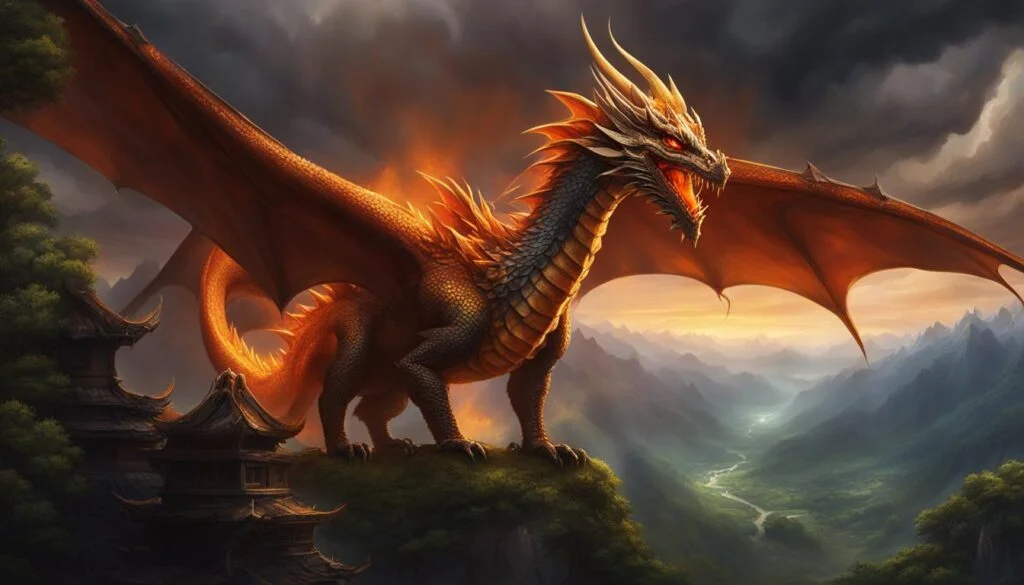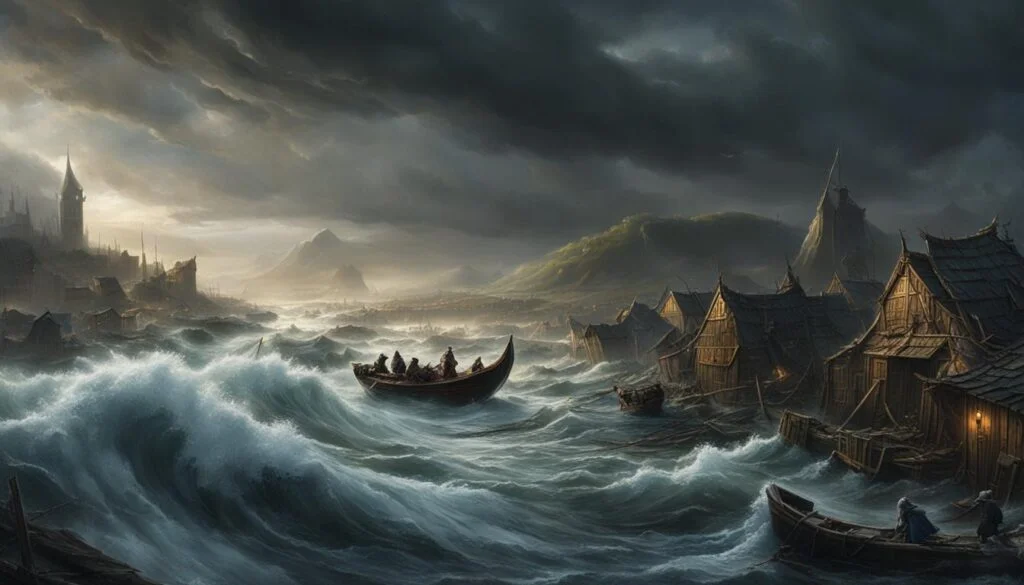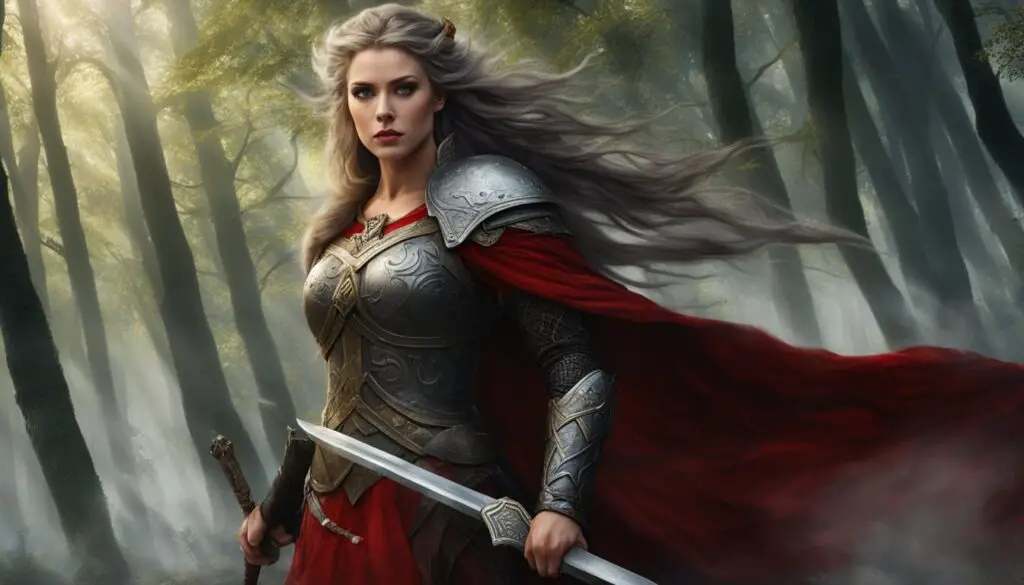Dragons have long been a fascinating subject in mythology and folklore. From Western tales of fire-breathing behemoths to Eastern legends of wise and noble creatures, dragons take on different forms and meanings across cultures. But what about Norse mythology? Does it contain its own version of these mythical creatures?
In Norse mythology, dragons indeed have a place. However, they may not exactly match the traditional image of dragons that we are familiar with. Norse dragons, known as “ormr” or “worm,” are often depicted as giant serpents rather than winged creatures. While most of these dragons were more like giant snakes, there were exceptions that had wings, like Nidhogg.
The three main dragons in Norse myths are Fafnir, Nidhogg, and Jormungandr. Their stories and symbolism shed light on the role dragons play in Norse culture and cosmology.
Key Takeaways:
- Norse mythology features dragons known as “ormr” or “worm,” which are depicted as giant serpents.
- Dragons in Norse mythology include Fafnir, Nidhogg, and Jormungandr, each with their own unique stories and symbolism.
- While Norse dragons may not match the traditional image of dragons from other mythologies, they hold significance in Norse cosmology.
- Dragons in Norse mythology symbolize chaos, destruction, wisdom, guardianship, and the cyclical nature of life and death.
- The stories of Fafnir, Nidhogg, and Jormungandr provide insights into the origins, symbolism, and significance of dragons in Norse culture.
The Dragons of Norse Mythology: Fafnir
Fafnir is a fascinating dragon in Norse mythology with a unique origin story. Originally born as a dwarf, Fafnir’s transformation into a dragon was driven by his insatiable greed. This transformation is a central element in the Saga of the Volsungs, a mythical tale that narrates the encounter between Fafnir and the Norse hero Sigurd.
Sigurd embarks on a quest to make a name for himself and seeks to slay Fafnir, who guards a vast hoard of treasure. The dragon’s hoard symbolizes the corrupting power of wealth and serves as a cautionary tale about the perils of greed. Sigurd successfully defeats Fafnir and claims the dragon’s precious hoard.
This image portrays the awe-inspiring Fafnir, showcasing the compelling visual representation of this legendary dragon. Its inclusion adds depth to the article and enhances the reader’s engagement with the material.
The Dragons of Norse Mythology: Nidhogg
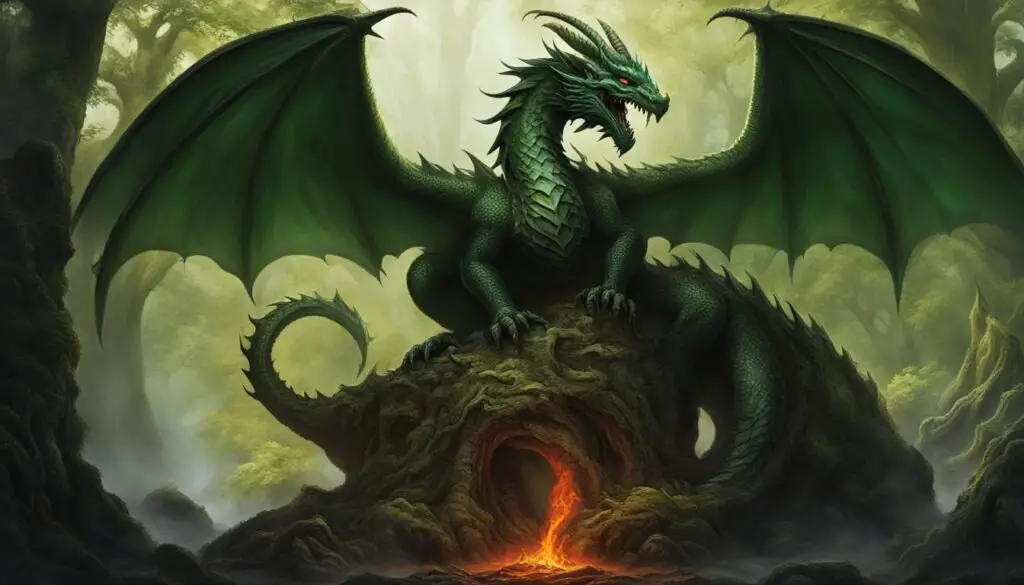
Nidhogg is a prominent dragon in Norse mythology. Depicted as a serpent, it plays a significant role in Norse cosmology by gnawing at the roots of Yggdrasil, the World Tree. Yggdrasil holds the nine realms together, making Nidhogg’s actions a threat to the stability of the entire cosmos.
This mighty dragon symbolizes decay and destruction and is closely associated with the underworld. In Norse mythology, Nidhogg’s constant gnawing represents the ongoing process of decay and the inevitable cycle of death and rebirth. Its insatiable hunger for the roots of Yggdrasil reflects the destructive forces that can undermine the balance of the Norse cosmological order.
During Ragnarok, the apocalyptic battle that marks the end of the world in Norse mythology, Nidhogg emerges from the depths of the earth. As it rises, it brings with it the corpses of the dead, contributing to the chaos and devastation that ensues.
Just as Nidhogg’s actions threaten the stability of the cosmos, its presence in Norse mythology serves as a reminder of the constant struggle between order and chaos. The serpent’s gnawing represents the inevitable forces of decay and destruction that are inherent in the cycle of life and death.
The Dragons of Norse Mythology: Jormungandr
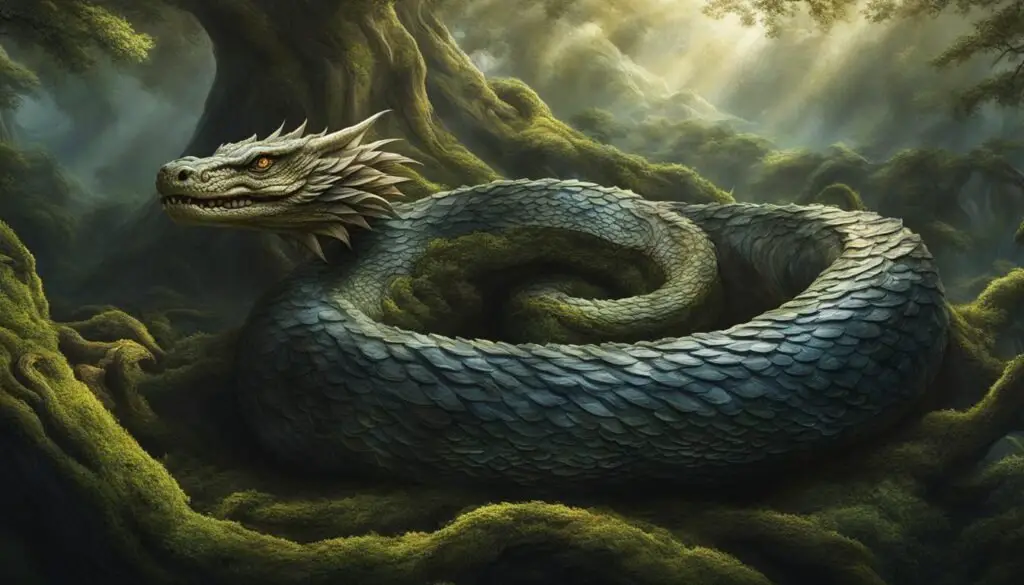
Jormungandr, also known as the Midgard Serpent or World Serpent, is a well-known dragon in Norse mythology. This massive serpent encircles the entire world with its tail in its mouth. Jormungandr represents chaotic and destructive forces and plays a significant role in Ragnarok—the apocalyptic battle between the gods and giants.
Ragnarok, the end of the world battle, marks the ultimate confrontation between the forces of good and evil in Norse mythology. Jormungandr’s involvement in this cataclysmic event signifies the immense power and threat it poses to the cosmos. As the cosmos crumbles during Ragnarok, Jormungandr unleashes its fury, ready to engage in a battle of epic proportions.
One of the key figures in this apocalyptic battle is Thor, the god of thunder. Thor’s clash with Jormungandr is nothing short of legendary. The mighty Thor fights valiantly against the World Serpent, engaging in an intense battle that shakes the very foundations of the world.
In the apocalyptic struggle against Jormungandr, Thor ultimately manages to slay the serpent. However, victory comes at great cost. As Jormungandr falls, it unleashes a final venomous strike, fatally poisoning Thor.
This dramatic clash between Thor and Jormungandr encapsulates the significance of the dragon in Norse mythology. Jormungandr represents chaos, destruction, and the eternal cycles of creation and annihilation. Its defeat marks the end of one era and the beginning of a new one. Through this mythological battle, Norse culture highlights the transient nature of existence and the constant struggle between order and chaos within the cosmos.
Dragons in Norse Mythology: Symbolism and Significance
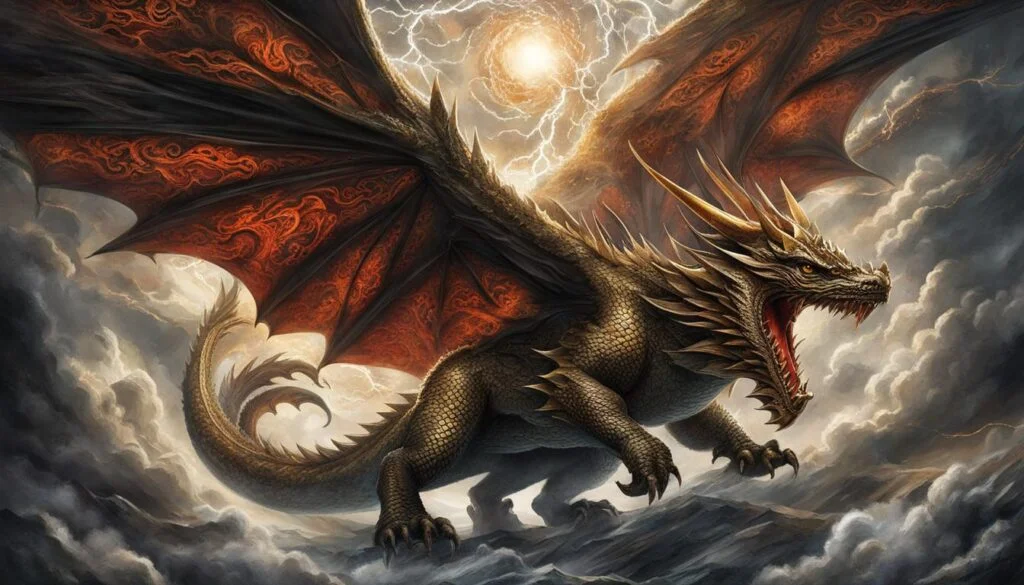
Dragons in Norse mythology play a significant role as mythological creatures, carrying various symbolic meanings. They are not mere beasts but powerful symbols that represent fundamental aspects of the Norse worldview.
One prevalent theme associated with dragons in Norse mythology is chaos and destruction. These majestic creatures often pose a threat to the established order, symbolizing the disruptive forces that can undermine societal structures and bring about chaos.
However, dragons in Norse mythology also possess qualities of wisdom and guardianship. Despite their destructive potential, they are revered for their immense knowledge and protective instincts. In some tales, dragons act as guardians of precious treasures or sacred realms, using their wisdom to guide and protect.
Furthermore, dragons embody the cyclical nature of life and death in Norse mythology. The transformation of Fafnir, originally a dwarf turned into a dragon by his greed, signifies the eternal cycle of transformation and rebirth. Similarly, the release of Jormungandr’s tail during Ragnarok symbolizes the end of one cosmic cycle and the beginning of another.
In Norse mythology, dragons serve as powerful metaphors, representing both destructive forces and significant symbolic concepts. They invite contemplation of the fragile balance between chaos and order, the wisdom that can emerge from destruction, and the perpetual cycle of life and death.
Explore the awe-inspiring world of Norse dragons and delve into the rich mythology that weaves together these mythical creatures, chaos, wisdom, and the cyclical nature of life and death.
Conclusion
Dragons hold a significant place in Norse mythology, embodying both destructive forces and symbolic meanings. These powerful creatures feature prominently in tales that highlight the eternal struggle between order and chaos, as well as the consequences of greed. While the dragons in Norse mythology may not conform to the traditional image of dragons found in other mythologies, they are deeply rooted in Norse cosmology and hold a unique significance.
Throughout Norse culture, dragons represent more than just mythical creatures. They serve as powerful symbols, offering insights into the origins and complexities of the Norse worldview. The stories of Fafnir, Nidhogg, and Jormungandr provide us with valuable glimpses into the symbolism and significance of dragons in Norse mythology.
The origins of dragons in Norse mythology date back to ancient times, reflecting the profound belief in the cyclical nature of life and death. These creatures embody the transformative power of greed, as seen in the tale of Fafnir, who was transformed from a dwarf into a dragon due to his insatiable desire for wealth. Additionally, dragons like Nidhogg and Jormungandr represent the constant threat of chaos and destruction, reminding us of the delicate balance of the cosmos as depicted in Norse cosmology.
FAQ
Does Norse mythology feature dragons?
Yes, Norse mythology does feature dragons, although they may not match the traditional image of dragons. They are known as “ormr” or “worm” and are often depicted as giant serpents or winged creatures.
What are the main dragons in Norse mythology?
The three main dragons in Norse mythology are Fafnir, Nidhogg, and Jormungandr. Fafnir is a dwarf who transformed into a dragon due to greed. Nidhogg is a serpent that gnaws at the roots of the World Tree. Jormungandr is a massive serpent that encircles the entire world.
Who is Fafnir in Norse mythology?
Fafnir is a unique dragon in Norse mythology because he was originally a dwarf. He transformed into a dragon due to his insatiable greed. The Saga of the Volsungs tells the story of Fafnir and the Norse hero Sigurd, who sets out to slay him and claim his treasure.
What is the significance of Nidhogg in Norse mythology?
Nidhogg is a prominent dragon in Norse mythology. It is depicted as a serpent that gnaws at the roots of the World Tree, Yggdrasil. This dragon symbolizes decay and destruction and poses a threat to the stability of the cosmos.
Who is Jormungandr in Norse mythology?
Jormungandr, also known as the Midgard Serpent or World Serpent, is a well-known dragon in Norse mythology. It is a massive serpent that encircles the entire world, representing chaotic and destructive forces. It plays a significant role in Ragnarok, the apocalyptic battle between gods and giants.
What do dragons symbolize in Norse mythology?
Dragons in Norse mythology carry various symbolic meanings. They often represent chaos, destruction, and the struggle between order and chaos. However, dragons can also symbolize wisdom and guardianship. They embody the cyclical nature of life and death.


